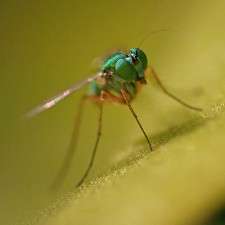Do our bodies' bacteria play matchmaker?

(PhysOrg.com) -- Could the bacteria that we carry in our bodies decide who we marry? According to a new study from Tel Aviv University, the answer lies in the gut of a small fruit fly.
Prof. Eugene Rosenberg, Prof. Daniel Segel and doctoral student Gil Sharon of Tel Aviv University's Department of Molecular Microbiology and Biotechnology recently demonstrated that the symbiotic bacteria inside a fruit fly greatly influence its choice of mates.
The research was done in cooperation with Prof. John Ringo of the University of Maine, and was recently published in the Proceedings of the National Academy of Sciences (PNAS).
Love, marriage and fruit flies
Based on a theory developed by Prof. Rosenberg and Dr. Ilana Zilber-Rosenberg, the scientists propose that the basic unit of natural selection is not the individual living organism, plant or animal, but rather a larger biological milieu called a holobiont. This milieu can include plant or animal life as well as their symbiotic partners. In the case of animals, these partners tend to be microorganisms like intestinal bacteria.
"Up to now, it was assumed that the host organism undergoes evolution on its own, while its symbiotic bacteria undergo their own evolution," Prof. Rosenberg says. "The mechanism that we discovered enables evolution to occur more rapidly in response to environmental changes. Since a generation is shorter for bacteria than for multicellular organisms, they genetically adjust more quickly to changes in the holobiont," says Prof. Rosenberg.
Conducting their experiments on the rapidly-reproducing fruit fly, the scientists were able to test this new theory. The first experiment repeated a study carried out two decades ago by a Yale University researcher, in which a fly population was divided in half and fed different diets ― malt sugar versus starch. A year later, when the flies were re-integrated as one group, those who had been fed starch preferred starch-fed mates, while the sugar-fed flies preferred mates of a similar nutritional background. The repeat experiment carried out by the Tel Aviv University researchers shows that this dietary influence takes effect within just a generation or two rather than over an entire year.
In their second experiment, the Tel Aviv University team repeated the first, but with the addition of an antibiotic, which killed the bacteria and eliminated the specific mate preference. The mating process became random, with no dietary influence.
In subsequent experiments, the researchers successfully isolated the bacterial species responsible for reproductive isolation in flies with diet-related mating preferences, and found the bacteria Lactobacillus plantarum to be present in greater numbers in starch-fed fruit flies than in sugar-fed flies. When L. plantarum was reintroduced into the antibiotic-treated flies, the preferential mating behavior resumed ― proving that this bacterial species is at least partly responsible for the mating preference.
Rewriting Darwin?
Finally, in cooperation with Prof. Avraham Hefetz of Tel Aviv University's Department of Zoology, the team analyzed the sexual pheromones produced by the fruit flies. There turned out to be differences in pheromone levels between the two groups of flies − differences that again disappeared after administering antibiotics.
"The finding indicates that pheromone alterations are a mechanism by which we can identify mating preferences. We therefore hypothesize that it is the bacteria that are driving this change," Prof. Rosenberg says. He adds that these discoveries have implications for our entire understanding of natural selection –– something which may even lead to the development of a new theory of evolution.
Provided by Tel Aviv University



















